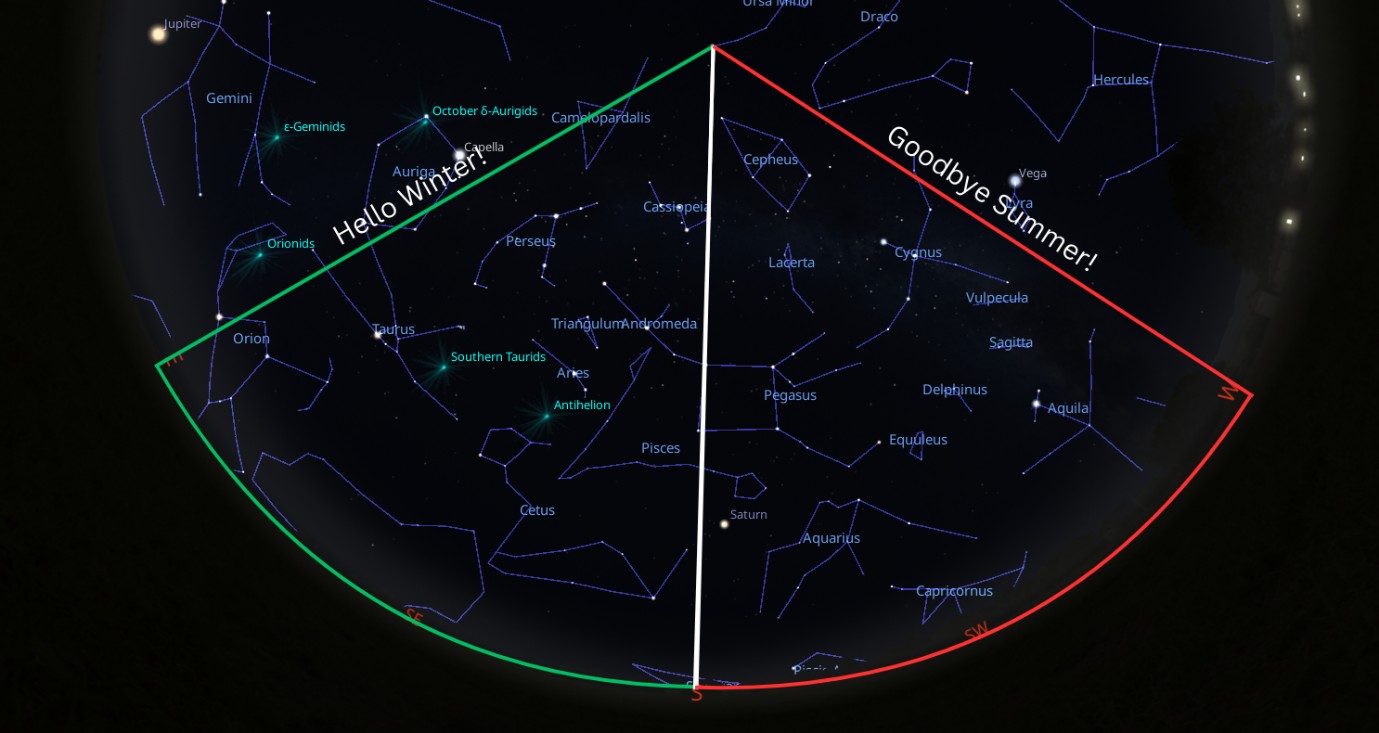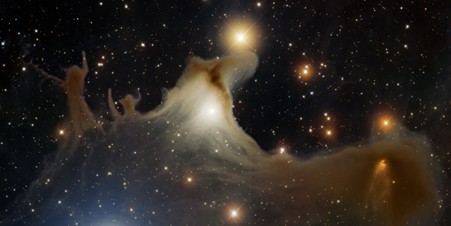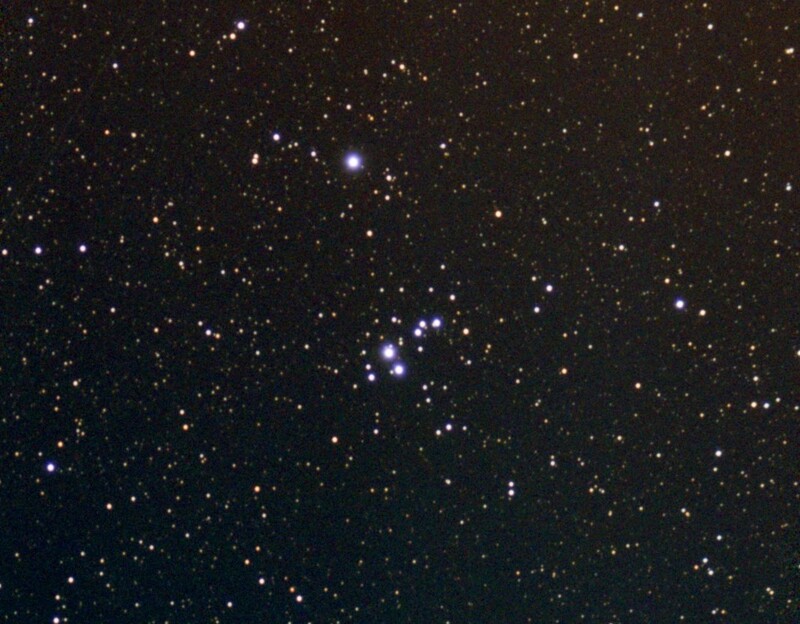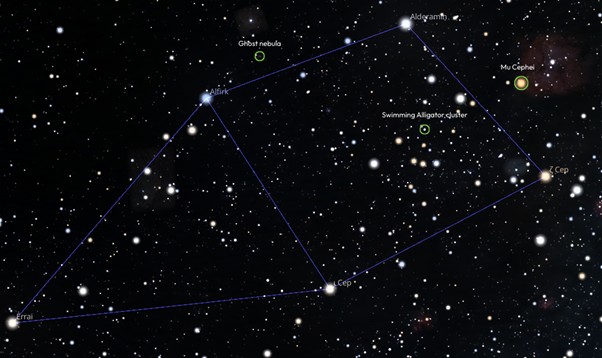What's Up? October 2025
October skies are full of magic, and we’ve got clear nights lined up for stargazers!
Say goodbye to summer constellations and hello to winter favourites like the Pleiades, Taurus, and Orion, which brings the spectacular Orionid meteor shower later in the month. For telescope users, the Ghost Nebula and the Swimming Alligator Cluster are October highlights. Plus, catch Saturn and Jupiter rising as the nights grow longer.
Read on to plan your perfect night under the stars!
“Double, double toil and trouble; Fire burn and cauldron bubble.” We’ve been casting all sorts of spells to bring clear skies to October because what a month it is! Hopefully the spells work, in which case you have the following to look forward to-
Constellations
As aware as I am that the sky is always moving and changing, there is something about October that always feels extra transitional. It almost like the sky jumps from Summer to Winter out of nowhere. In the west Arcturus in Boötes will be setting a few hours after the Sun and not far behind are summer favourites like Hercules with his glob, and by the end of the month the Summer Triangle will be firmly in the western quadrant of the sky.
As we wave goodbye to Summer in the west, the eastern sky is looking increasingly wintery. We’ve already spied the Seven Sisters, a.k.a the Pleiades, a few times at the Observatory during late night events in August and September, but by October they are rising at far more sociable hours and should be visible through much of the night. With the Seven Sisters, we of course start to regain Taurus in the sky.
And then, guess who’s back in the house? Orion! At the beginning of October you’ll need to wait until after 1am to see the Hunter up in the sky, but by the end he’ll be around from 11pm. Orion doesn’t come emptyhanded either- the Orionid meteor shower is active from October 2nd to November 7th with the peak falling on the 21st/22nd which is during the New Moon.

The sky on the 15th October around midnight. The green coloured quadrant on the left shows a typically “winter” sky rising in the East, where the red quadrant on the right shows typical “summer” constellations setting in the west. Credit: Stellarium
Object of the Month
Ghost Nebula (Bonus: Swimming Alligator Cluster).

The Ghost Nebula (Sh 2-136, LDN 1177, VdB 141). Image taken with the Mayall 4 m telescope on Kitt Peak. T.A. Rector, H. Schweiker, NOIRLab/NSF/AURA, 2009
This is one for the astrophotographers really, the Ghost Nebula has a visual brightness of 9.4 mag which will make it faint even through a telescope, but it’s high position and seasonally appropriate name makes it my main pick for the month. However, in light of it’s visual dimness I will take the opportunity to shout out another near-by object for those who only have their eyes and a moderately powerful telescope.
The Ghost Nebula is a reflection nebula in Cepheus which appears to have two ghosts reaching up to escape the interstellar dust. Reflection nebulae are clouds of dust which reflect the light of nearby stars, as opposed to emission nebulae which are themselves ionised to produce light. Another example of a reflection nebula can be found in the Seven Sisters with the Merope Nebula.
For those who lack astrophotography equipment, my bonus object for you is the Swimming Alligator Cluster, also in Cepheus. This open cluster is still rather small, in fact you will find it described in some places as a “poor cluster”, but it’s a great target for those with a telescope. It’s also relatively straightforward to locate.

NGC 7160 - Swimming Alligator Cluster. Credit: Herseycart SeeStar S50
Last month we taught you how to locate Mu Cephei, also known as the Garnet Star, and that is step 1. To find the Swimming Alligator, imagine the bottom line that makes the ‘house’ of Cepheus as a mirror and the Swimming Alligator is the mirror image of Mu Cephei.
 The locations of the Ghost Nebula, Swimming Alligator Cluster, and Mu Cephei in Cepheus. Credit: Stellarium
The locations of the Ghost Nebula, Swimming Alligator Cluster, and Mu Cephei in Cepheus. Credit: Stellarium
The Orionids
As briefly mentioned in the constellations section, in October we see the peak of the Orionids meteor shower. It’s not the only shower going on, the Draconids are active 6-10 October and peak on the 8th but that falls too close to the full moon to expect much activity. The Orionids, by contrast, will peak around the 21/22 which is right around new moon.
The peak rate of the Orionids is 15 per hour making it only moderately active, but it’s association with Halley’s comet makes it special. As Halley’s comet swings into the inner solar system once every 75-76 years it leaves behind a trail of debris which crosses the Earth’s orbital path around the Sun. When the Earth reaches this intersection point the debris enters our atmosphere producing meteors.
The Moon
Full Moon: 7th October
Last Quarter: 13th October
New Moon: 21st October
First Quarter: 29th October
The Planets
Mercury: not visible at night
Venus: rising later each night
Mars: not visible at night
Jupiter: will rise earlier as the month goes on, located in Gemini
Saturn: visible through the night, located in Pisces
















